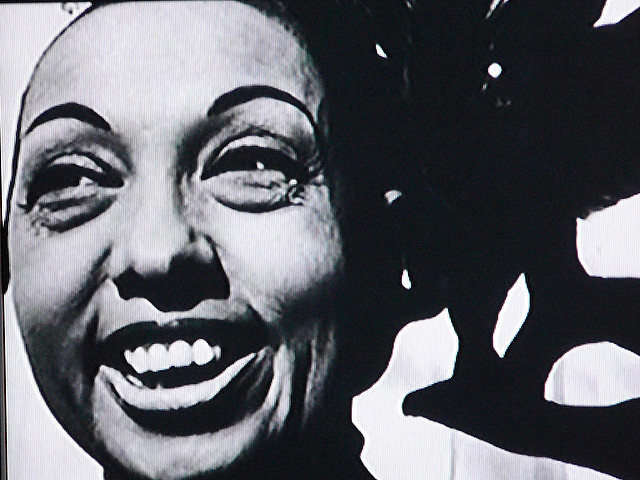Josephine Baker was black America’s first international stage and film star. She was a woman who, tired and angry over Jim Crow racism in the United States, was early among African American artists and intellectuals in relocating to France. Baker’s career opposed and repudiated the narrow provincialism endemic to US racism.
American memory has done poorly by Josephine Baker. While she can be found in many books and documentaries on the Roaring Twenties, the scale and longevity of her accomplishments remain missing. Baker is not invisible in the United States, but despite being honored by Google she remains far less visible than her historical presence merits.
Given French admiration for her, it comes as no surprise that a massive eponymous graphic biography of Josephine Baker arrives as a translation into English from the French original. Part of Baker’s continuing appeal in France comes from providing an historical argument for French cosmopolitanism, an ability to appreciate and incorporate a range of cultures. Josephine Baker is the American who does not behave like a stereotyped boor, embraces France as a citizen, performs in vivid French, and infuses new cultural vitality. In Josephine Baker (Self-Made Hero, 2017), Catel Muller (artist) and José-Louis Bocquet (text) have contributed greatly to the re-exploration of her life.
Baker had opportunities in France that a black woman did not have in segregated US society and she did not have to deal with the daily outrage of a color line. At the same time the French and European obsession with Baker’s ‘primitivism’, which she played into with her famous banana dance, spoke to a racism magnetized by the erotic possibilities of blacks. In the twilight of European colonialism she symbolized the elusive native, the one who sang, danced, and tantalized but remained independent. Emerging half-naked on stage from a giant cage, Baker capitalized on barely-repressed European racial fantasies and turned them into a personal fortune. As she said, “Leers and dirty looks are two sides of the same coin.”
The African American world paid close attention to Baker and the Revue Négre as they conquered Paris. W.E.B Du Bois took note of her in The Crisis and the African American press chronicled her successes. Middle-class white Americans, few of whom had ever seen Baker perform during her US career, knew of Baker but paid her little more than brief attention. It was in Europe where Baker had the most profound impact as the American image of the Jazz Age. Two Americans especially mattered to Europeans in the 1920s: Woodrow Wilson and Josephine Baker.
Baker and in a larger sense jazz dance music provoked European racism into heated anger. Not only had the First World Ward visibly drained European power, but now a ‘vulgar’ and ‘primitive’ American black woman was parading either topless or barely-clothed across the stages of European capitals to huge acclaim. Schubert, Strauss, and proprieties were not receiving due attention. When Baker’s revue appeared in cities such as Berlin and Vienna, the conservative and fascist press whipped up a negerskandal protesting Baker as an affront to proper values.
While Muller and Bocquet focus justifiably on the racism that Baker encountered, her European reception equally embodied an intensification of conflict between modernism and anti-modernism. Baker’s life intertwined with a host of modern artists – Colette, Luis Bunuel, Sidney Bechet, Adolf Loos, Erich Maria Remarque, Max Reinhardt, Luigi Pirandello – and more than a few were her lovers – Eubie Blake, Le Corbusier, George Simenon. This is a fascinating set of historical connections and important to understand. Yet as Muller and Bocquet skate over these stories it becomes more like name-dropping from a past golden age.
Lyotard suggests reading postmodernism as an antecedent stage of modernism, understanding modernism through a paradoxical reversal. Can we understand Baker not as antecedent history where Eros discovers modernist expression, but instead as futurity itself? Was Baker a part of twentieth-century modernism or part of the future? The freedom and mocking fun that remains so attractive in Baker’s dances and songs makes her intensely contemporary.
Josephine Baker was engagé. Her politics were anti-racist to the core, although she had a tendency to stumble in embracing authoritarian governments. In 1935 Baker cheered on Mussolini’s invasion of Ethiopia as a supposed attack on slavery and in the mid-1960s she celebrated the Castro government at a point when the nature of its dictatorship had long been clear. Muller and Bocquet attempt to ease through explanations of these points, but there is little need. The long arc of Baker’s opposition to racism and her civil rights activism mattered most. In the 1963 March on Washington, she was one of the speakers on the Lincoln Memorial steps next to Martin Luther King. The book, for which Baker’s son Jean-Claude Bouillion-Baker served as consultant and wrote an afterword, is especially attentive to her ‘rainbow tribe’ family of a dozen children she adopted from around the world. In her family Baker created a vision of the non-racial world she worked to realize.
The black-and-white artistry of Catel Muller is intense and appealing. She does particularly well in capturing the changes in Baker’s aging face. Muller has developed an expansive canon of graphic work focusing on women’s lives. This is the third in a series of graphic biographies with Bocquet on the lives of women who deserve historical attention. The first was on revolutionary feminist and abolitionist Olympe de Gouges; the second concerned the artist and model Kiki de Montparnasse (Alice Prin). Muller by herself has done graphic biographies of actress Mylène Demongeot and writer Benoîte Groult.
The book is a massive 568-page production, with over 80 pages of extensive biographical notes of primary and secondary figures and a bibliography. The translation from French by Edward Gauvin and Mercedes Claire Gilliam is fluid and idiomatic. However, a public complaint needs lodging against the publishers for removing the translators’ names from the title page, where they belong, to minute 8-point type lines on the copyright page. Translation is a craft no less than authorship and artwork, and translators deserve full and respectful recognition.
Photographs courtesy of Pierre and Vielle Announces. Published under a Creative Commons license.






